Media | Articles
Removing a transmission on a mid-rise lift
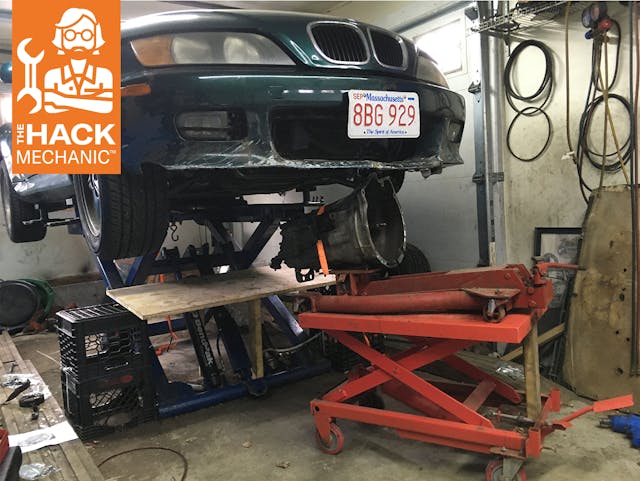
As soon as I sold my friend Mike’s 1973 BMW 2002tii on Bring A Trailer, and it no longer occupied space in my garage, I suddenly had some space. For about a minute. Since nature abhors a vacuum, I bought back Zelda, the 1999 BMW Z3 2.3 that I’d sold to my friend and neighbor Kim two years ago—the one her son crashed into a median strip and I repaired for her.
I had been on the fence about buying back the car, both because I was thinking of filling that last remaining over-winter garage space with something new and different (meaning something American or Japanese, or, if worst came to worst, a needy Boxster), and also because in addition to the accident damage, the car’s clutch release bearing had failed to the point where it sounded like a chainsaw. I wasn’t looking forward to pulling the transmission to do the clutch, but in the end, the fact that I could buy the Z3 back for a fraction of the cost of any other running roadster was simply too good to pass up.
Figuring that there was no time like the present, I immediately put the car on my mid-rise lift and began the winter project of removing the transmission and replacing the clutch.
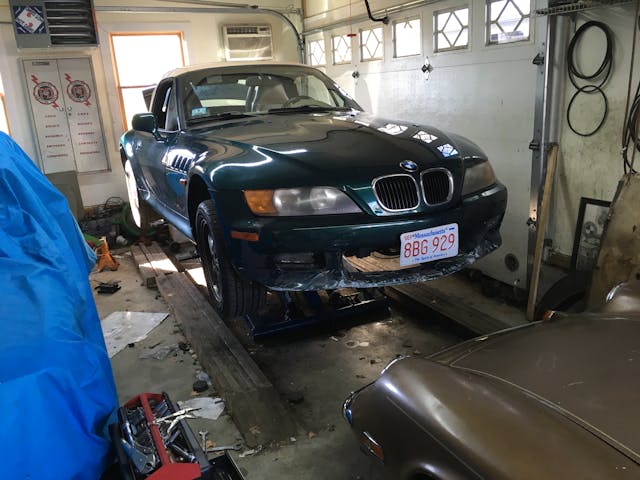
While nothing beats a post lift and the ability to walk and work unobstructed beneath a car, a mid-rise scissors lift can raise a car high enough that you can sit fully upright beneath it, and believe me, that’s waaaaaaaaay better than working under a car on jack stands. I bought my BendPak MD-6XP about 10 years ago, and I use it constantly. Project cars may spend weeks or months on it. For most repairs, the fact that the middle 2/3 of the car sits over the body of the lift isn’t an issue because the lift has cut-outs you can scurry in and out of, so you can easily reach the exhaust, driveshaft, bellhousing bolts, and everything else you need to disconnect to pull the transmission out, maybe not as easily as on a post-lift, but way easier than if the car is on jack stands and you’re lying on your back. And if you have the upper body strength to just reach in, grab the transmission, pull it out, and stick it back in, there’s plenty of clearance to do so. The problem, for us 98-pound weaklings who can’t do that, is the inability to easily use a transmission jack.
First, understand that “transmission jack” can mean five things. If you have a shop with a full-height post lift, your transmission jack is a chest-high tripod with wheels on the bottom, a long hydraulic cylinder in it, and a multiply articulated cradle on the top. While standing under the car, you roll the jack into position, orient the cradle under the transmission by adjusting its pitch and roll, throw the chain over the transmission to secure it, de-couple the transmission from the engine by rolling it back, lower the jack, and simply roll it and the transmission out from under the car. Short-height versions of this design are also available to roll under a car that’s on jack stands. The other design is basically a floor jack with an integrated cradle. You can also buy a cheap cradle to replace the jack pad of your existing floor jack, or you can use a floor jack without a cradle and just balance the gearbox on it as best you can.
Marketplace
Buy and sell classics with confidence
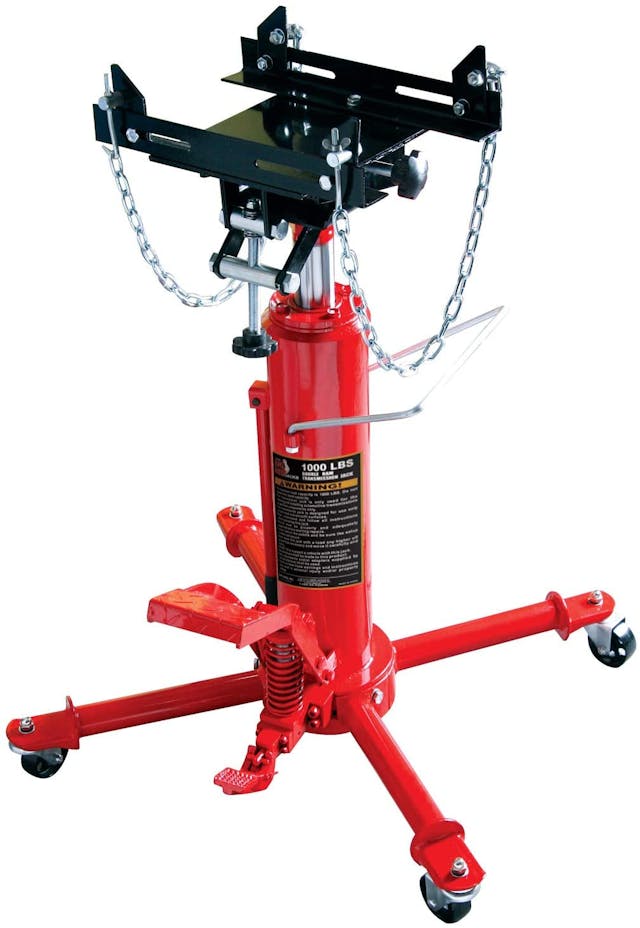
Me, I have a 1962 Hein-Warner transmission floor jack. The thing weighs about as much as a Volkswagen engine, but man, they really don’t build ’em like this anymore—after nearly 60 years, the play-free articulated movement of the cradle is a thing of beauty, in contrast with the nearly useless angle adjustment controls you find on an inexpensive Chinese-made cradle.
But the problem is that, with the car on a mid-rise lift, there’s no way to roll any of these jacks under the transmission because the lift itself—specifically, the legs and the big hydraulic cylinders—is in the way. Note that there are now “open-center mid-rise lifts,” essentially two narrow mid-rise platforms with a gap in the middle and a common hydraulic control, but they are more expensive.

About seven years ago, while one of my cars was on the lift high enough for me to sit upright under it, I looked at it and noticed that the legs and cylinders were at less than a 45-degree angle to the ground and realized that there was enough room above them for a jack. I had an epiphany that, if a jack could somehow hover about two feet up off the floor, it could position itself directly under the transmission. The more I thought about it, the more I realized that it really wasn’t that hard to do—I just needed some sort of platform or shelf to raise the jack and allow it to roll. I went through a few iterations of how to do it. The final iteration is by far the best, and that’s what I’ll talk about here. I hadn’t used the technique in quite a few years, but I just revisited it, and with a few caveats, it worked very well.
That having been said, let me satisfy my inner lawyer by telling you not to do what I’m about to describe. That is, this is how I did it, but don’t do it yourself. (My inner lawyer is now tossing back drinks with little umbrellas in them on a beach with sky-blue waters.)
I take two pairs of milk crates, lash them together with zip ties, and put them on either side of the inner legs of the lift, which are about 40 inches apart.
I take a stiff 3/4-inch-thick 4-foot-by-2-foot plywood board and lay it on top of the milk crates. That puts about 4 inches of each end of the board over each milk crate stack. A 5- or 6-foot-long board would be better, as more of it would sit on top of the crates, but 4 feet by 2 feet is a standard size that’s available at big-box hardware stores without cutting.
I accurately measure the height of the board, cut a pair of 2x4s to that height, and screw one in front and one in back of the board to brace it from tipping and prevent the middle from sagging.
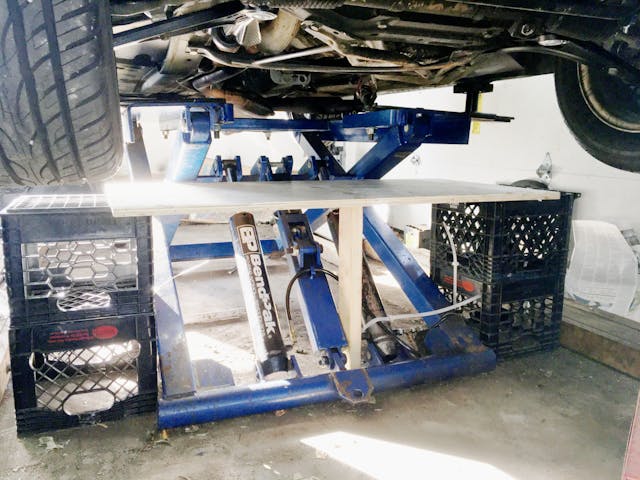
But that’s not the end, because if I put the jack on the platform as pictured, the jack wouldn’t have any running room. That is, to remove a transmission, you have to first move the jack backward to get the transmission input shaft out of the clutch splines and clear of the clutch fingers, then lower the jack to drop the transmission, then move the jack forward to pull the transmission out from under the car, and one can’t do all that on a little 2-foot-deep platform.
Now, what one could do is simply use more boards and milk crates to extend the platform far enough to let you roll the jack and the transmission forward, but instead of doing that, I came up with a method that looks a bit Rube Goldberg-like but works incredibly well—I use a scissors lift table, the kind you can buy at Harbor Freight or Tractor Supply for about $180. I have one left over from when I had my Porsche 911SC (a mid-rise lift and a lift table make rear-engine Porsche engine drops so easy that it almost isn’t fair). I put my transmission jack on the lift table, raise the table until it’s equal with the height of the wooden platform, and roll the transmission jack onto the platform. In doing this, it solves two problems: 1) It puts the transmission jack directly under the transmission where it can reach up and lower, and 2) It provides a means to roll the jack and transmission out from under the car.

I hadn’t done this in years, but it all worked. I ran to Home Depot, bought the 3/4-inch 4-foot-by-2-foot piece of plywood for about $20, assembled the little platform, braced it front and back, dug the lift table and my ancient and venerable 1962 Hein-Werner transmission jack out from under my back porch, put the former atop the latter, and rolled them into position. I found that the hydraulic cylinder on my lift table had developed a leak, causing the table to slowly lose height, so I cut two pieces of 2×4 to ensure it wouldn’t sink below the height of the platform.

There were two surprises that I didn’t have the last time I did this. The first was that, since the Z3 is a low little car, the transmission is way up under the hump, so even when the jack was fully lowered, the transmission didn’t come close to clearing the bottom of the car.

Of course, with the car on the mid-rise lift, I could simply raise the height of the lift. I did, but that resulted in the second surprise. The mid-rise lift is a scissors lift, so as it rises, its geometry changes—the legs pull toward each other and the hydraulic lift cylinders become more vertical. In doing so, the pistons extending from the cylinders began to rub against the back edge of the platform, eventually pushing it and causing the platform to tip slightly toward the nose of the car. I couldn’t just pull the platform away from the cylinders and toward the nose because one of the bracing legs was flush with the back of the leg of the lift. I could’ve used a Sawzall to notch the plywood platform where it was hitting the pistons, but I didn’t want to put my body under a lift that was not yet sitting securely on a lock-stop. Instead, I raised the lift in small increments and pulled the milk crates toward the front of the car to help ensure that the forward-facing edge of the platform wouldn’t tip further (note that the platform was still braced against tipping with a screwed-in 2×4).
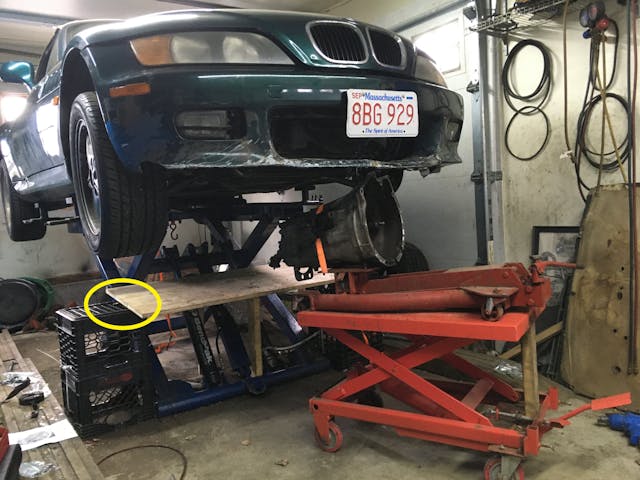
Before I reinstall the transmission, I’ll cut those notches in the platform to clear the pistons and ensure it doesn’t tip forward again. I may also use a second row of milk crates to provide a wider base for the platform and improve the bracing a bit. But the bracing gets into a subtle issue of one of the downsides of doing this, and it’s that the platform—the shelf and the bracing—completely occupies the space where you need to put your body if you have to crawl back under the nose of the car. So if you forgot to, say, undo the reverse lamp switch—or worse, if the transmission separates from the engine but then stops because it’s hitting something and you need to figure out what—in order to get back under there, you have to take the platform down. And in my case, to do that, even with the simple bracing—two 2x4s, each held in by one screw from the top—the screws had to be removed.
If my wife and I ever move and buy a house with a garage with enough height to accommodate a post lift, I’d jump at the opportunity to upgrade. But, until then, even with its downsides, I find my technique for transmission removal on a mid-rise lift to be very workable. The alternatives are A) Trying to muscle the transmission out without a jack (the gearbox in the Z3 weights about 80 pounds, so, no thanks), or B) Putting the car on the cement, jacking it up, putting it on jack-stands, and using a transmission jack. The older I get, the less tolerance I have for spending hours on my back under a car, and the more heebie-jeebies I get muscling things around while I’m under one. And, since I don’t ever get under a car unless it’s supported by jack stands and a redundant floor jack, once you add the transmission jack into the mix, you run into a similar issue of restricted access anyway.
But if you’re considering pulling a transmission on a mid-rise lift, just remember that I told you not to try to do it the way I did.
***
Rob Siegel has been writing a column (The Hack Mechanic™) for BMW CCA Roundel magazine for 34 years and is the author of seven automotive books. His new book, The Lotus Chronicles: One man’s sordid tale of passion and madness resurrecting a 40-year-dead Lotus Europa Twin Cam Special, is now available on Amazon (as are his other books), or you can order personally-inscribed copies from Rob’s website, robsiegel.com.
















